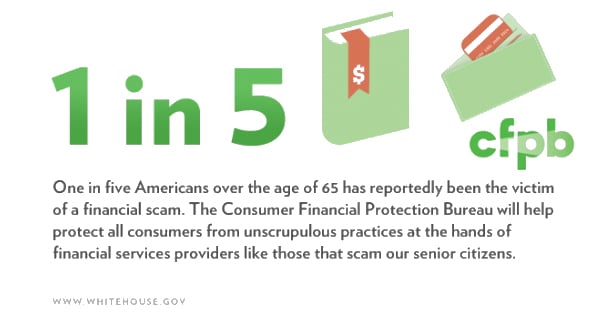Breaking Down The Consumer Financial Protection Bureau (CFPB)
This is a guest contribution from friend of the site, Bill Hazelton. Bill has authored a number of prominently featured articles on personal finance and entrepreneurship and has been quoted and featured as a source in CNN Money, Forbes Magazine, Business Insider, Entrepreneur Magazine, All Business, and a variety of other publications. In this piece, Bill provides a helpful overview of the Consumer Financial Protection Bureau (CFPB), a government agency with growing importance and influence in the consumer banking realm. We also plan to further explore the CFPB’s findings in and effects on depository banking practices in particular in a future piece.
Instituting a regulatory body that protected consumers from the abusive practices of the financial service industry was an idea first proposed in 2007 by Elizabeth Warren, then a professor at Harvard Law School and currently a senior U.S. Senator from Massachusetts.
In response to the financial crisis starting in 2008, Congress passed the Dodd-Frank Wall Street Reform and Consumer Protection Act in July of 2010. The Dodd-Frank Act established the Consumer Financial Protection Bureau (CFPB) as a means to protect consumers from the dubious practices employed by financial firms and service providers leading up to the crisis. The CFPB officially opened its doors on July 21st, 2011.
The major areas of responsibility for the CFPB include education, enforcement and research:
Education – Educating consumers about their financial options is an important facet of the CFPB. Because of a lack of awareness and education about certain financial matters, many consumers have made poor financial decisions, resulting in devastating financial consequences. To help prevent consumers from being taken advantage of, the CFPB has provided a feature on their website called Ask CFPB, allowing consumers to ask financial questions and get answers in easy-to-understand terminology. The Ask CFPB topic coverage includes questions surrounding their most frequently asked questions on a wide variety of financial subject matters.
Enforcement – The CFPB was given the regulatory authority to supervise financial service providers, to enforce all Federal consumer financial protection laws, and to take direct action to restrict any abusive, deceptive or unfair practices against consumers. The aim of the CFPB with respect to enforcement as outlined in the Dodd Frank Act is "to implement and, where applicable, enforce Federal consumer financial law consistently for the purpose of ensuring…that markets for consumer financial products and services are fair, transparent, and competitive."
Research – The bureau has also been tasked with gathering and analyzing information on consumer behavior to better understand consumers, financial service providers, and consumer financial markets. Primary areas of CFPB research include studies on consumer behavior and consumer complaint investigation. To that end, the CFPB has built an Office of Research to support its commitment to so-called "evidence-based policymaking" and will produce findings that deepen the public’s understanding of the problems that consumers, companies, and markets encounter in the area of financial services. The Office of Research will also conduct research on a variety of financial topics and will publish findings under the CFPB’s name. Researchers will be given the latitude to "choose their own topics, data, and methodology themselves, draw their own conclusions, and publish in their own names."
The CFPB was established as a means to educate and inform consumers about emerging financial risks and threats, to enforce financial regulations amongst financial service providers and to provide an active research mechanism for consumers and financial service firms alike. Specific areas within financial services that the CFPB regulates include elder abuse, mortgages, credit reporting, debt collection, student lending, credit cards, investment fraud and bank fees.
Elder Abuse
One of the largest consumer groups in the U.S. often targeted by unscrupulous financial service providers is the elderly. According to a CFPB study, 20 percent of all Americans over the age of 65 have been victims of a financial scam. American seniors face unique financial challenges that are very different compared to other consumers. Seniors are more prone to financial scams because many simply don’t have the awareness or the education they need to avoid these dubious financial scams. The CFPB provides a curriculum to help educate seniors entitled "Money Smart for Older Adults – Prevent Financial Exploitation".

More information on the CFPB website specific to seniors includes:
- How seniors can protect their financial well-being and guard against dubious financial products and service providers.
- Helping seniors to understand what their financial options are if their spouse passes away.
- Helping seniors to make difficult decisions regarding their finances, their long-term care planning and their retirement.
- How seniors can identify scam artists that are targeting them because of their home equity or net worth.
Credit and Debt
Many consumers in the U.S. have well-documented challenges with credit and debt. Whether it's falling into debt or avoiding debt altogether, being unable to keep up with debt payments or being discriminated against when it comes to obtaining credit, U.S. consumers have a long and tortured history with credit and debt.
The credit and debt cycle can be a vicious cycle, which is why the CFPB has established a number of regulations in order to safeguard and protect consumers specifically in this area.
-
Mortgages – The steady rise in home values over the past century has built the foundation for a multitrillion-dollar mortgage industry in the U.S.
Leading up to the subprime mortgage crisis in 2008, the traditional disclosure forms covering the final terms and costs of a mortgage were notorious for legal and technical jargon that made it incredibly difficult for the average consumer to truly understand, leading them to sign off on financing terms that may not have been in their best interest.
The CFPB collected feedback on how to make the mortgage forms more clear and used it to launch the Know Before You Owe program, replacing the two old disclosure forms with one easy to read form.
Individuals who have fallen behind on their mortgage payments and are facing foreclosure can also submit a complaint about the foreclosure threat and acquire information about getting a HUD-approved housing counselor directly through the CFPB.
-
Debt Collection – According to the Federal Reserve, as of June 2014, there is roughly $724 billion in delinquent consumer debt in the United States. The growth in consumer debt has led to a boom in the debt collection industry in the U.S. and, along with it, increasingly aggressive and predatory tactics being used by debt collectors. Unfortunately, far too many debtors are simply not educated enough about how to protect themselves against predatory, deceptive or abusive debt collection behavior.
The CFPB website provides in-depth information on debt collection consumer protections, how to respond to predatory collection tactics and how individuals can negotiate a settlement with their debt collectors.
The main law that governs the debt collection industry and protects consumers is the 1977 Fair Debt Collection Practices Act (FDCPA). In 2010, the Consumer Protection Act revised the FDCPA, making the Bureau the first agency with the power to issue substantive rules under the statute.
Fortunately for debtors, the CFPB has instituted the Advance Notice of Proposed Rulemaking (ANPR), which gives the Bureau wide latitude to gather information about the accuracy of information used by debt collectors, how to ensure consumers know their rights, and the communication tactics collectors employ to recover debts. Additionally, the CFPB also added consumer complaints about debt collections to its public Consumer Complaint Database as well.
-
Credit Reporting – With just three privately held credit reporting agencies dominating the entire industry, the sheer size of the credit reporting system in the U.S. is startling, with 1.3 billion consumer credit accounts covering more than 200 million American adults.

Not surprisingly, managing the flow of credit-reporting data for the major credit bureaus does not come without significant challenges. The National Consumer Law Center, in a 2012 study, documented very serious flaws in the credit reporting system, citing widespread errors in account reporting, irresponsible debt collection tactics and a flawed system for resolving disputes. In December of 2012, the CFPB also released a follow-up study on how the nation’s largest credit bureaus manage consumer data, providing regulators and consumers with a framework for how the industry really works. "If consumers know how these companies handle their credit histories, they can make better decisions on how to handle their financial lives," said CFPB Director Richard Cordray.
In addition to their oversight, the CFPB also provides basic information on credit reporting as well as guidelines and recommendations for consumers on various credit reporting topics including:
- How to obtain a credit history and credit score
- How to maintain a good credit score
- How to spot identity theft
- How to report any errors that were made on a credit report.
-
Student Lending – The student loan market in the U.S. is approaching $1.2 trillion dollars with a staggering seven million student loan borrowers that are currently in default on federal or private student loans.
As a result of the growing student loan problem, the CFPB now provides a wide variety of information for students and young Americans on how to pay for college, how to manage college money, how to repay student loan debt and even how to submit a student loan complaint.
Additional research provided by the bureau on student loans includes reports on student loan affordability and a financial aid shopping sheet to help improve the way schools communicate financial aid offers to students. The shopping sheet lets students compare financial aid offers on more than 1,500 colleges nationwide.
-

Credit Cards – Because of the complexity and terminology of traditional credit card agreements, many consumers have found it difficult to understand what they’re actually signing up for. In fact, the CFPB has received thousands of credit card complaints to date, and many of them have to do specifically with the complexity of the language in credit card agreements.
The bureau created a much simpler prototype for a new credit card agreement that’s shorter, simpler and much easier to understand, and it features this agreement along with a complaint database to let the public know what is being complained about and why.
Additionally, the CFPB also provides a number of useful databases for consumers, including a glossary of credit card terms, a survey of credit card plans and a separate database of credit card agreements on more than 300 card issuers nationwide.
Investment Fraud
One of the primary reasons the CFPB was formed was the lack of a governing body that held any kind of regulatory authority over financial services firms. The Dodd-Frank Act was passed specifically in order to hold financial firms accountable for dubious practices and to protect American consumers from fraudulent practices employed by financial services firms. The CFPB provides information and assistance to consumers to help prevent investment fraud where investors are induced to make investment decisions or purchases predicated on false information, which can often lead to devastating financial losses. Some of the investment fraud resources that the CFPB provides includes the Trick$ of the Trade: Outsmarting Investment Fraud documentary and the Fighting Fraud Partner Toolkit.
- False and deceptive claims – The Dodd-Frank Act has made it illegal to mislead the consumer using false and deceptive claims when it comes to investing. This doesn’t just protect consumers from false claims but also applies to information that was withheld from the consumer as a way to mislead them. Statements made to the consumer that can be interpreted as having more than one meaning can also be considered deceptive.
- CFPB research on bad practices in financial services – Not only does the CFPB provide resources to help consumers protect against investment fraud and to help them make smarter financial decisions, it also publishes research on bad practices within the financial services industry to help consumers avoid similarly deceptive industry practices.
Bank Accounts and Services

A healthy ecosystem of community banks and credit unions is important to ensure a transparent, competitive and fair marketplace for consumers in the financial services marketplace. The CFPB provides a regulatory backdrop to provide consumers with not only fair access to these products and services but a means to fully understand them as well. The CFPB website is a valuable source of information on checking accounts, money market accounts, debit card usage, automatic withdrawals, wage garnishes and much more.
The CFPB has plans to launch another website that will post firsthand accounts of consumer’s bad experiences with financial service companies, including banks and credit unions, to warn consumers about banking and credit union practices to be wary of.
Fee Protection – Almost everyone is familiar with the fact that many of the services that banks provide come with fees and penalties that can really add up for the average consumer. While the initial focus of the CFPB primarily focused on mortgages, the bureau has since turned its attention to bank practices that make it difficult for consumers to anticipate and avoid fees on deposit accounts. Because of the fact that fees and penalties have been such a huge source of consumer complaints, the CFPB is now actively pursuing a means to disclose fees and penalties for consumers from banks, credit unions and all financial services firms. In comments made at a Roosevelt Institute conference, director Cordray cited the "$40 cup of coffee." A man swipes his debit card at his local Starbucks, and unbeknownst to him, his balance is too low to cover the cost. Rather than the card being declined, the $5 transaction is processed, along with a $35 overdraft fee.
-

Overdraft fees – Overdraft fees occur when consumers withdraw more money than is currently available in their account (as in the example above). The bank or credit union covers the overage and then charges a fee for it. Unfortunately, many banks have been accused of manipulating the order in which credits and debits post, processing the transactions in a way such that they can maximize the overdraft fee charges that are made. In response, the CFPB is actively monitoring the bank practice of commingling of bill payments, ATM withdrawals, debit card and check transactions each day and processing the largest transactions first in an effort to deliberately manufacture more overdraft fees. Additionally, the CFPB is looking into how clearly banks disclose their overdraft terms and whether consumers are being misled about those terms.
-
ATM fees – When using an ATM in order to withdraw cash from a checking account, consumers will usually be charged a small fee for doing so. In 2012, an amendment was passed eliminating the requirement to post a fee notice directly on the ATM machine. However, disclosure about any ATM fees is required on the ATM screen or the printout, and the consumer is allowed to cancel the transaction if they do not agree with the amount of the fee without any additional costs.
The CFPB commissioned a wide-ranging study of overdraft programs in the U.S. that examined how the programs are marketed, how terms and fees are disclosed by banks, and their overall impact on consumers.
While Director Cordray has leaned toward simplifying fee disclosures about how and when overdraft charges would apply and wants to provide consumers more visibility about how and when different charges would clear an account to help them avoid overdrafts, the bureau plans to study the issue more broadly and collect more data before planning any specific actions to curtail overdraft charges.
The CFPB has not shown any indication that it intends to ban overdraft protection either. "Nothing in our report implies that banks and credit unions should be precluded from offering overdraft coverage," Cordray said. However, a recently-reported significant decrease in bank fee revenue has been credited to the CFPB’s efforts to shine a light on some of the more unsavory fee practices in the industry.
Investigations and Enforcements
In addition to informing the consumer about various financial services and products, the CFPB is also responsible for investigating financial institutions and enforcing the regulatory boundaries required by law. The CFPB does this with the help of the consumer by asking consumers to file complaints if they feel they have been misled or deceived by a financial institution.
Complaint database – The complaint database holds all complaints made by consumers about certain products and services as well as the response to each complaint made by the company that is associated with them.
-
Filing a Complaint – When a consumer files a complaint, the complaint will be sent by the CFPB to the company to give them the opportunity to respond. The complaint will be published as part of the complaint database – but no personal information will be released.

The CFPB has made progress in enforcing new regulatory statutes in the financial services industry and in educating consumers when it comes to making decisions about certain financial services or products. It continues to seek ways to identify and eliminate deceptive financial practices to protect consumers by establishing a feedback loop that actively engages consumers in the regulatory monitoring process and encourages the cooperation of consumers and companies alike. Whether it stands as a shining example of government’s irreplaceable ability to protect its citizens, or a shining example of big government seeking to insert itself and unseat capitalism from its due course, or somewhere in between…is best left for another piece.
 What Is Bank Fraud? How to Recognize It, Avoid It and Report It
What Is Bank Fraud? How to Recognize It, Avoid It and Report It How to Open a Bank Account for a Minor
How to Open a Bank Account for a Minor How to Balance a Checkbook
How to Balance a Checkbook Retirement Savings: How Much Should I Save Each Month?
Retirement Savings: How Much Should I Save Each Month?


